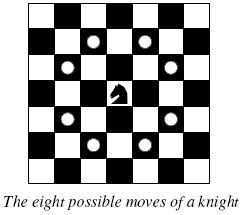HDOJ-三部曲一(搜索、数学)- A Knight's Journey
A Knight's Journey
Time Limit : 2000/1000ms (Java/Other) Memory Limit : 131072/65536K (Java/Other)
Total Submission(s) : 51 Accepted Submission(s) : 17
Problem Description
 Background The knight is getting bored of seeing the same black and white squares again and again and has decided to make a journey around the world. Whenever a knight moves, it is two squares in one direction and one square perpendicular to this. The world of a knight is the chessboard he is living on. Our knight lives on a chessboard that has a smaller area than a regular 8 * 8 board, but it is still rectangular. Can you help this adventurous knight to make travel plans?
Background The knight is getting bored of seeing the same black and white squares again and again and has decided to make a journey around the world. Whenever a knight moves, it is two squares in one direction and one square perpendicular to this. The world of a knight is the chessboard he is living on. Our knight lives on a chessboard that has a smaller area than a regular 8 * 8 board, but it is still rectangular. Can you help this adventurous knight to make travel plans? Problem Find a path such that the knight visits every square once. The knight can start and end on any square of the board.
Input
The input begins with a positive integer n in the first line. The following lines contain n test cases. Each test case consists of a single line with two positive integers p and q, such that 1 <= p * q <= 26. This represents a p * q chessboard, where p describes how many different square numbers 1, . . . , p exist, q describes how many different square letters exist. These are the first q letters of the Latin alphabet: A, . . .
Output
The output for every scenario begins with a line containing "Scenario #i:", where i is the number of the scenario starting at 1. Then print a single line containing the lexicographically first path that visits all squares of the chessboard with knight moves followed by an empty line. The path should be given on a single line by concatenating the names of the visited squares. Each square name consists of a capital letter followed by a number. If no such path exist, you should output impossible on a single line.
Sample Input
3
1 1
2 3
4 3
Sample Output
Scenario #1:
A1
Scenario #2:
impossible
Scenario #3:
A1B3C1A2B4C2A3B1C3A4B2C4
Source
PKU
第一次写深搜,感觉还不错
#include<iostream>
#include<cstring>
using namespace std;
int m,n;
int c; //已走过的步数
bool f; //标记是否找到答案了
int chess[30][30]={0};
int step[2][8]={{-1, 1,-2, 2,-2,2,-1,1}, //每一种可能的走法,注意要按字典序排列
{-2,-2,-1,-1, 1,1, 2,2}};
char ans1[64];
int ans2[64];
bool move(int i,int j,int k)
{
if(i+step[0][k]>=0&&i+step[0][k]<m&&j+step[1][k]>=0&&j+step[1][k]<n&&!chess[i+step[0][k]][j+step[1][k]])
{
chess[i+step[0][k]][j+step[1][k]]=1;
return true;
}
else
return false;
}
void DFS(int i,int j)
{
ans1[c]=j+'A';
ans2[c]=i+1;
if(c==m*n) //找到结果,回退
{
f=true;
return;
}
for(int t=0;t<8;t++) //尝试每一种走法
{
if(move(i,j,t))
{
c++;
DFS(i+step[0][t],j+step[1][t]);
if(c==m*n) //如果找到结果就一直回退
return;
chess[i+step[0][t]][j+step[1][t]]=0; //还原
c--;
}
}
return;
}
int main()
{
int T;
cin>>T;
int t=T;
while(T--)
{
int i,j,k;
cin>>m>>n;
for(j=0;j<n;j++)
{
for(i=0;i<m;i++)
{
c=1;
memset(chess,0,sizeof(chess));
chess[i][j]=1;
f=false;
DFS(i,j);
if(f)
{
cout<<"Scenario #"<<t-T<<":"<<endl;
for(k=1;k<=m*n;k++)
cout<<ans1[k]<<ans2[k];
cout<<endl;
break;
}
}
if(f)
break;
}
if(!f)
{
cout<<"Scenario #"<<t-T<<":"<<endl;
cout<<"impossible"<<endl;
}
cout<<endl;
}
}

